Last updated on
You can use some bathroom cleaners in the kitchen, but there are important things to consider before doing so.
I have seen my fair share of cleaning mishaps. From using the wrong cleaner on delicate surfaces to forgetting to dilute bleach, I have witnessed it all.
However, one question that always seems to come up is whether or not you can use bathroom cleaner in the kitchen. It may seem like a simple answer, but the truth is that it’s not as straightforward as you may think.
So let me tell you a story about a client of mine who learned this lesson the hard way and why it’s important to pay attention to what cleaners you use where in your home.
Key takeaways:
- Different cleaners are formulated for specific purposes
- Bathroom cleaners can be too abrasive for kitchen surfaces
- Harsh chemicals in bathroom cleaners can be harmful if not used properly
- Read labels carefully and follow instructions for safe usage
- Cross-contamination risks can occur when using bathroom cleaners in the kitchen.
What's Inside
Kitchen vs. Bathroom Cleaners

When my client, let’s call her Sarah, decided to clean her kitchen counters with the same bathroom cleaner she used in her shower, she didn’t think twice about it. After all, a cleaner is a cleaner right? Wrong.
Kitchen and bathroom cleaners are formulated differently for specific purposes.
Bathroom cleaners are designed to tackle soap scum and hard water stains that accumulate in showers and tubs. They contain harsh chemicals like bleach or ammonia that can be too abrasive for surfaces found in kitchens such as granite countertops or stainless steel appliances.
On the other hand, kitchen cleaners are made specifically for cutting through grease and grime on cooking surfaces without damaging them. These products often have gentler ingredients than their bathroom counterparts but still pack enough punch to get rid of stubborn food stains.
So before you reach for any old cleaning product under your sink next time you’re tidying up your home – make sure it’s appropriate for the surface you’re cleaning!
Chemicals in Cleaning Products

When it comes to cleaning products, it’s important to understand the chemicals that are in them. Bathroom cleaners often contain harsher chemicals like bleach and ammonia, which can be effective at removing tough stains and grime but can also be harmful if not used properly.
On the other hand, kitchen cleaners tend to have milder ingredients like vinegar or baking soda.
My client learned this lesson when she accidentally grabbed a bottle of bathroom cleaner instead of her usual kitchen spray while cleaning up after dinner one night. She didn’t think much of it until she started experiencing headaches and nausea shortly after using the product.
After some investigation, we discovered that the bathroom cleaner contained high levels of ammonia which had caused her symptoms. This experience taught us both an important lesson about being mindful of what products we use where in our homes.
It’s crucial to read labels carefully before using any cleaning product and follow instructions for proper use. Always wear gloves when handling harsh chemicals and make sure there is adequate ventilation in your workspace as well.
By understanding what chemicals are present in your household cleaners you can ensure safe usage practices while keeping your home clean!
Safe Cleaning Practices

After my client’s unfortunate experience, I made it a point to educate myself on safe cleaning practices. It is essential to understand that different surfaces require different types of cleaners.
For example, bathroom cleaners are formulated with harsh chemicals such as bleach and ammonia that can damage kitchen surfaces like granite or marble countertops.
To avoid any mishaps in your home, always read the labels on cleaning products before using them. If you’re unsure about which cleaner to use for a particular surface, do some research or consult with a professional.
Another important aspect of safe cleaning practices is proper ventilation. When using strong chemicals like bleach or ammonia-based cleaners in enclosed spaces without proper ventilation can be hazardous and cause respiratory problems.
Taking the time to learn about safe cleaning practices will not only protect your family but also prolong the life of your household items and keep them looking their best for years to come!
Disinfecting Surfaces

After my client’s unfortunate experience, I decided to do some research on the topic of using bathroom cleaner in the kitchen. One thing that stood out was the importance of disinfecting surfaces properly.
While it may be tempting to use a strong bathroom cleaner for its disinfectant properties, it’s important to note that not all cleaners are created equal.
When it comes to disinfecting surfaces in your home, you want a product that is effective against bacteria and viruses but also safe for food preparation areas. Look for products with active ingredients such as hydrogen peroxide or citric acid instead of harsh chemicals like bleach or ammonia.
It’s also essential to follow instructions carefully when using any cleaning product and avoid mixing different types of cleaners together as this can create dangerous fumes and increase cross-contamination risks.
While there may be some overlap between kitchen and bathroom cleaning products’ uses, they should never be used interchangeably without careful consideration. Always read labels carefully before use and choose appropriate products based on their intended purpose – whether you’re looking at disinfection capabilities or general surface cleaning needs -to ensure your family stays healthy while maintaining a clean home environment.
Cross-Contamination Risks

My client, let’s call her Sarah, had just finished cleaning her bathroom with a powerful bleach-based cleaner. She then proceeded to clean the kitchen counters with the same product without realizing that she was putting herself and her family at risk of cross-contamination.
Cross-contamination occurs when bacteria or viruses are transferred from one surface to another through contact. In this case, using a bathroom cleaner in the kitchen can lead to harmful pathogens being spread throughout your food preparation areas.
It’s important to understand that different surfaces require different types of cleaners. Bathroom cleaners are designed for use on hard non-porous surfaces such as tiles and porcelain whereas kitchen cleaners should be used on food preparation areas like countertops and cutting boards.
To avoid cross-contamination risks in your home, always read labels carefully before using any cleaning products. Make sure you’re using appropriate products for each area of your home and follow safe cleaning practices such as washing hands frequently while handling chemicals or wearing gloves if necessary.
By taking these simple steps, you can ensure that your family stays healthy while maintaining a clean home environment!




